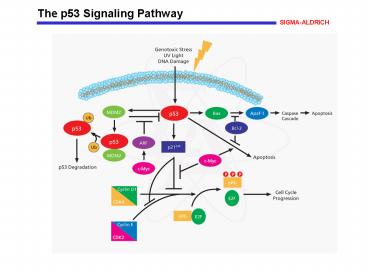The p53 Signaling Pathway PowerPoint PPT Presentation
Title: The p53 Signaling Pathway
1
The p53 Signaling Pathway
SIGMA-ALDRICH
2
The p53 Signaling Pathway The tumor-suppressor
protein p53 exhibits sequence-specific
DNA-binding, directly interacts with various
cellular and viral proteins, and induces cell
cycle arrest in response to DNA damage. In
response to signals generated by a variety of
genotoxic stresses, e.g, UV irradiation or DNA
damage, p53 is expressed and undergoes
post-translational modification that results in
its accumulation in the nucleus. The
p53-dependent pathways help to maintain genomic
stability by eliminating damaged cells, either by
arresting them permanently or through apoptosis.
For example, ?-irradiation activates p53 to turn
on the transcription of p21CIP1, that, in turn,
binds to and inhibits cyclin-dependent kinases,
causing hypophosphorylation of retinoblastoma
(Rb), thus preventing the release of E2F and
blocking the G1-S transition. Some of the
cellular effects of p53 can be blocked by the
deregulated expression of c-Myc, Bcl-2, or E2F.
p53 activity is controlled through an
autoregulatory loop involving Mdm2. The binding
of Mdm2 to p53 targets p53 for degradation and
inhibits p53-induced cell-cycle arrest and
apoptosis. References Gu, J., et al.,
Identification of a sequence element from p53
that signals for Mdm2-targeted degradation. Mol.
Cell Biol., 20, 1243-1253 (2000). Jimenez, G.S.,
et al., p53 regulation by post-translational
modification and nuclear retention in response to
diverse stresses. Oncogene, 18, 7656-7665
(1999). King, K.L., and Cidlowski, J.A., Cell
cycle regulation and apoptosis. Annu. Rev.
Physiol., 60, 601-617 (1998).
PowerShow.com is a leading presentation sharing website. It has millions of presentations already uploaded and available with 1,000s more being uploaded by its users every day. Whatever your area of interest, here you’ll be able to find and view presentations you’ll love and possibly download. And, best of all, it is completely free and easy to use.
You might even have a presentation you’d like to share with others. If so, just upload it to PowerShow.com. We’ll convert it to an HTML5 slideshow that includes all the media types you’ve already added: audio, video, music, pictures, animations and transition effects. Then you can share it with your target audience as well as PowerShow.com’s millions of monthly visitors. And, again, it’s all free.
About the Developers
PowerShow.com is brought to you by CrystalGraphics, the award-winning developer and market-leading publisher of rich-media enhancement products for presentations. Our product offerings include millions of PowerPoint templates, diagrams, animated 3D characters and more.

